
Gasparo Martellini (Florence, February 15, 1785 -October 20, 1857) was an Italian painter.

Gasparo Martellini (Florence, February 15, 1785 -October 20, 1857) was an Italian painter.
He was a pupil of Pietro Benvenuti at the Academy of Fine Arts, Florence. He developed an affinity to the atavistic Purismo style of Lorenzo Bartolini.
He helped paint frescoes in the Hall of Ulysses in the Pitti Palace. The frescoes represent Ulysses returning to Ithaca. He painted in 1841 the lunette depicting Session of Experiments at the Accademia del Cimento for the Tribune of Galileo. For the Spinelli Chapel of the Church of Santa Croce, he painted lunettes and walls with Coronation of the Virgin and Church Militant and the prayer by Florence after the plague of 1633. [1] [2]
He also painted lunette with Sinite parvulos (Let the children come to me) for the portico of the Ospedale degli Innocenti, commissioned in 1843 by the architect Federico Pasqui. [3]
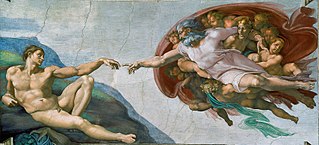
Fresco is a technique of mural painting executed upon freshly laid ("wet") lime plaster. Water is used as the vehicle for the dry-powder pigment to merge with the plaster, and with the setting of the plaster, the painting becomes an integral part of the wall. The word fresco is derived from the Italian adjective fresco meaning "fresh", and may thus be contrasted with fresco-secco or secco mural painting techniques, which are applied to dried plaster, to supplement painting in fresco. The fresco technique has been employed since antiquity and is closely associated with Italian Renaissance painting.

Paolo Uccello, born Paolo di Dono, was an Italian Renaissance painter and mathematician from Florence who was notable for his pioneering work on visual perspective in art. In his book Lives of the Most Excellent Painters, Sculptors, and Architects, Giorgio Vasari wrote that Uccello was obsessed by his interest in perspective and would stay up all night in his study trying to grasp the exact vanishing point. Uccello used perspective to create a feeling of depth in his paintings. His best known works are the three paintings representing the battle of San Romano, which were wrongly entitled the Battle of Sant'Egidio of 1416 for a long period of time.

Andrea del Castagno or Andrea di Bartolo di Bargilla was an Italian Renaissance painter in Florence, influenced chiefly by Masaccio and Giotto di Bondone. His works include frescoes in Sant'Apollonia in Florence and the painted equestrian monument of Niccolò da Tolentino (1456) in Florence Cathedral. He in turn influenced the Ferrarese school of Cosmè Tura, Francesco del Cossa and Ercole de' Roberti.
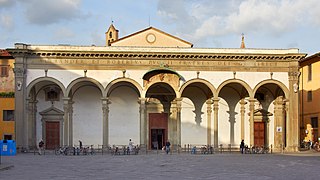
The Basilica della Santissima Annunziata is a Renaissance-style, Catholic minor basilica in Florence, region of Tuscany, Italy. This is considered the mother church of the Servite Order. It is located at the northeastern side of the Piazza Santissima Annunziata near the city center.

Domenico di Michelino (1417–1491) was an Italian Renaissance painter who was born and died in Florence. His birth name was Domenico di Francesco. The patronymic "di Michelino" was adopted in honour of his teacher, the cassone painter Michelino di Benedetto, by whom no works have been identified. Giorgio Vasari reports that Domenico was also a pupil of Fra Angelico, whose influence is reflected in many of Domenico's paintings along with that of Filippo Lippi and Pesellino.

Ventura di Archangelo Salimbeni was an Italian Counter-Maniera painter and printmaker highly influenced by the vaghezza and sensual reform of Federico Barocci.

Bernardino Poccetti, also known as Barbatelli, was an Italian Mannerist painter and printmaker of etchings.
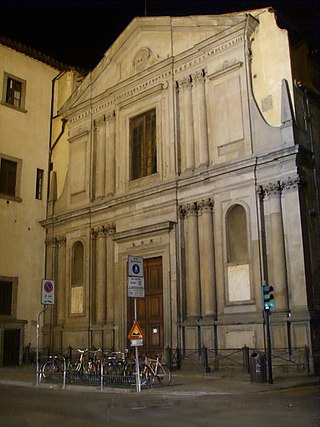
The church of San Giovannino degli Scolopi is a minor church in the center of Florence, located on Via Martelli corner with Via Gori.
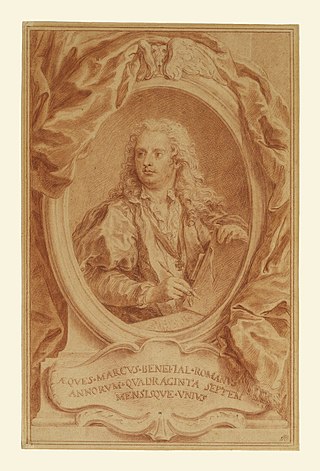
Marco Benefial was an Italian, proto-Neoclassical painter, mainly active in Rome. Benefial is best known for his repudiation of 18th century decorative Rococo styles pre-eminent in the Rome dominated by Carlo Maratta pupils. His paintings portrayed tangible human figures, with complex treatment of space, and luminous, warm colors. Along with the altarpieces and frescoes, he also painted many portraits. Because he partnered with some inferior artists who subsequently received credit, some of his paintings have been frequently misidentified.

Francesco Curradi or Currado was an Italian painter of the style described as Counter-Maniera or Counter-Mannerism, born and active in Florence.

Giovanni da San Giovanni, also known as Giovanni Mannozzi, was an Italian painter of the early Baroque period, active in Florence.
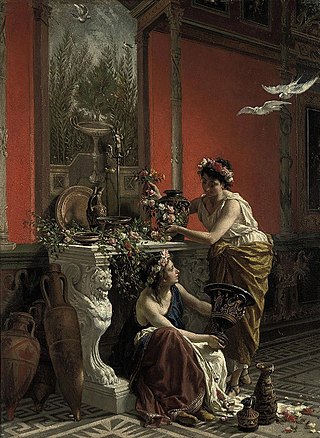
Cesare Mariani was an Italian painter and architect of the late-19th century, active in Rome and Ascoli Piceno.
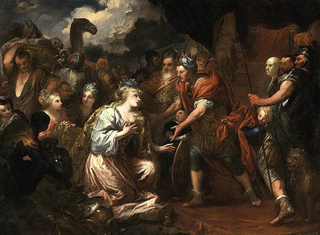
Pietro Dandini was an Italian painter of the Baroque period, active mainly in Florence.
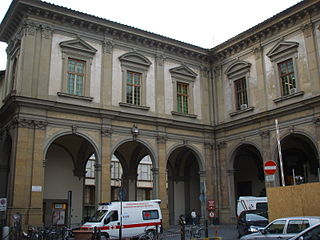
The Hospital of Santa Maria Nuova is the oldest hospital still active in Florence, Italy.

The Barbadori Chapel, later Capponi Chapel, is a chapel in the church of Santa Felicita in Florence, central Italy. It was designed by Filippo Brunelleschi, and was later decorated by a cycle of works by the Mannerist painter Pontormo.

Niccola Cianfanelli was an Italian painter and restorer. He mainly painted historic and sacred subjects in a Neoclassical style.

Giovanni Maria Ciocchi was an Italian painter and art critic, active during the Baroque period. He was born into a family of artists, and it is not clear if he is related to Giovanni Maria Ciocchi del Monte from Perugia, who became Pope Julius III. it is not clear that Giovanni Maria is related to the 16th century painter Ulisse Ciocchi.
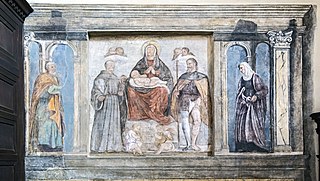
Girolamo Tessari, also called Gerolamo Tessari or Girolamo dal Santo, was an Italian painter, active in a Renaissance style in his native city of Padua.
Giacomo Cordelli was an Italian painter, active circa 1600–1620.

The Pinacoteca Civica di Palazzo Volpi is the town art gallery on Via Diaz 84 in the town of Como, Lombardy, Italy. It is housed in the 17th-century Palazzo Volpi.